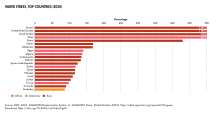Water resources management in Pakistan

According to the United Nations' "UN World Water Development Report", the total actual renewable water resources increased from 2,961 m³ per capita in 2000.[1] A more recent study indicates an available supply of water of little more than 1,000 m³ per person, which puts Pakistan in the category of a high stress country. Using data from the Pakistani federal government's Planning and Development Division, the overall water availability has decreased from 1,299 m³ per capita in 1996-97 to 1,101 m³ per capita in 2004-05.[2] In view of growing population, urbanization and increased industrialization, the situation is likely to get worse.[3] Nevertheless, excessive mining of groundwater goes on. Despite a lowering water table, the annual growth rate of electric tubewells has been indicated to 6.7% and for diesel tubewells to about 7.4%.[4] In addition, increasing pollution and saltwater intrusion threaten the country's water resources. About 36% of the groundwater is classified as highly saline.[5]
In urban areas, most water is supplied from groundwater except for the cities of Karachi, and a part of Islamabad, where mainly surface water is used. In most rural areas, groundwater is used. In rural areas with saline groundwater, irrigation canals serve as the main source of domestic water.[6]
Water use

Out of the 169,384 billion m³ of water which were withdrawn in 2000, 96% were used for agricultural purposes, leaving 2% for domestic and another 2% for industrial use.[7] By far most water is used for irrigated agriculture, emphasizing the particular significance of agriculture in the country. The sector contributes about 25% of the Pakistan's GNP (2000-2001).[8] The country still has the world's largest contiguous irrigation system.[9] In 1999-2000, the total irrigated area in Pakistan was 181,000 km².[10]
Water is also essential for power generation in Pakistan, since about 29% is generated through hydropower.[11]
See also
References
- ^ United Nations Educational, Scientific and Cultural Organization (March 2006). The 2nd UN World Water Development Report: 'Water, a shared responsibility' (PDF). New York: UNESCO. ISBN 92-3-104006-5. Retrieved 2008-05-28., p. 134
- ^ Government of Pakistan, Ministry of Economic Affairs and Statistics, Statistics Division. "Overall Water Availability" (PDF). Pakistan Statistical Year Book 2007. Retrieved 2008-06-06.
{{cite journal}}: CS1 maint: multiple names: authors list (link) The figures were converted into m³ and then divided by the population of the respective year, using data from http://devdata.worldbank.org/query/ - ^ Ministry of Finance (June 2007). "Pakistan Economic Survey 2006-07. Chapter 16: Environment" (PDF). Retrieved 2008-05-28.
{{cite journal}}: Cite journal requires|journal=(help), p. 248 - ^ Asian Development Bank (ADB) (November 2004). "RRP: PAK 37135. Report and recommendation of the president to the board of directors on proposed loans and technical assistance grants to the Islamic Republic of Pakistan for the Balochistan Resource Management Program" (PDF). Retrieved 2008-05-28.
{{cite journal}}: Cite journal requires|journal=(help), p. 11 - ^ Pakistan Water Gateway. "The Pakistan Water Situational Analysis" (PDF). Retrieved 2008-05-28., p. 4
- ^ Government of Pakistan. Ministry of Planning and Development (2004). "Medium Term Development Framework 2005-10. Section 10: Water and Sanitation" (PDF). Islamabad. Archived from the original (PDF) on 2009-03-04. Retrieved 2008-05-29.
{{cite journal}}: Cite journal requires|journal=(help), section 10.2. - ^ Bridges, Geoff; Asian Development Bank (ADB) (2007). "Asian Water Development Outlook 2007. Country Paper Pakistan" (PDF). Retrieved 2008-05-28.
{{cite journal}}: Cite journal requires|journal=(help), p. 5 - ^ Government of Pakistan. Ministry of Water and Power (October 2002). "Pakistan Water Sector Strategy. Executive Summary. Volume 1" (PDF). Retrieved 2008-05-29.
{{cite journal}}: Cite journal requires|journal=(help), p. 6 - ^ Government of Pakistan. Ministry of Water and Power (October 2002). "Pakistan Water Sector Strategy. Executive Summary. Volume 1" (PDF). Retrieved 2008-05-29.
{{cite journal}}: Cite journal requires|journal=(help), p. 3 - ^ Pakistan Water Gateway (2005). "The Pakistan Water Situational Analysis" (PDF). Retrieved 2008-05-28., p. 6
- ^ Pakistan Water Gateway (2005). "The Pakistan Water Situational Analysis" (PDF). Retrieved 2008-05-28., p. 8-9
External links
- "Pakistan Water Sector Strategy - Volume 1" (PDF). Pakistan Water Gateway. Retrieved 22 May 2014.
- "Pakistan Water Situation Analysis" (PDF). Pakistan Water Gateway. Retrieved 22 May 2014.
